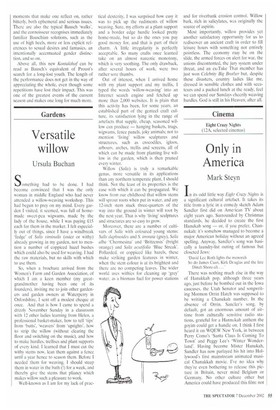Gardens
Versatile willow
Ursula Buchan
Something had to be done. I had become convinced that I was the only woman in middle England who had never attended a willow-weaving workshop. This had begun to prey on my mind. Every garden I visited, it seemed, was full of homemade sweet-pea wigwams, made by the lady of the house, while I was paying £15 each for them in the market. I felt especially out of things, since I have a windbreak ledge' of Safix viminalis (osier or vvithy) already growing in my garden, not to mention a number of coppiced hazel bushes which could also be used for weaving. I had the raw materials, but no skills with which to use them.
So, when a brochure arrived from the Women's Farm and Garden Association, of which I am a keen member (my greatgrandmother having been one of its founders), inviting me to join other gardeners and garden owners at Waterperry in Oxfordshire. I sent off a modest cheque at once. And that is how I came to spend a drizzly November Sunday in a classroom with 12 other ladies learning from Helen, a professional basket-maker, how to tell 'tips' from 'butts', 'weavers' from 'uprights', how to strip the willow (without clearing the floor and switching on the music), and how to make hurdles, trellises and plant supports of every kind. I learned that I must cut the withy stems now, lean them against a fence until a year hence to season them. Before I needed them for weaving, I should steep them in water in the bath (!) for a week, and thereby give the stems that pliancy which makes willow such a pleasure to work.
Well-known as I am for my lack of prac
tical dexterity, I was surprised how easy it was to pick up the rudiments of willow weaving. Sure, my efforts at a plant support and a border edge hurdle looked pretty home-made, but so do the ones you pay good money for, and that is part of their charm. A little irregularity is perfectly acceptable. So many crafts once learned take on an almost narcotic monotony, which is very soothing. The only drawback, after several hours of work, were two rather sore thumbs.
Out of interest, when I arrived home with my plant support and my trellis, I typed the words 'willow-weaving' into an Internet search engine and fetched up more than 2,000 websites. It is plain that this activity has been, for some years an established part of the genteel craft culture, its satisfaction lying in the range of artefacts that supple, cheap, seasoned willow can produce — hanging baskets, trugs, wigwams, fence panels, joky animals; not to mention 'living' willow sculptures and structures, such as crocodiles, igloos, arbours, arches, trellis and screens, all of which can be made from planting live willow in the garden, which is then pruned every winter.
Willow (Sa/ix) is truly a remarkable genus, more versatile in its applications than any northern temperate plant. I should think. Not the least of its properties is the ease with which it can be propagated. We know from our childhood that willow stems will sprout roots when put in water, and any 12-inch stem stuck three-quarters of the way into the ground in winter will root by the next year. That is why 'living' sculptures and structures are so easy to grow.
Moreover, there are a number of cultivars of Saltx with coloured young stems: Salix daphnoides and S. irrorata (grey), Salix alba Chermesina' and 'Britzensis' (bright orange) and Salix actitifolia 'Blue Streak'. Pollarded, or coppiced like hazels, these make striking garden features in winter, when the stem colour is at its brightest and there are no competing leaves. The wider world uses withies for cleaning up 'grey' water, as a biomass fuel for power stations and for riverbank erosion control. Willow bark, rich in salicylates, was originally the source of aspirin.
Most importantly, willow provides yet another satisfactory opportunity for us to rediscover an ancient craft in order to fill leisure hours with scimethaig not entirely pointless. The economy may be on the slide, the armed forces on alert for war, the unions discontented, the jury system under threat, and an ex-Take That member has just won Celebrity Big Brother but, despite these disasters, country ladies like me, dressed in sensible clothes and with secateurs and a packed lunch at the ready, feel we can spend our Sundays cheerily weaving hurdles. God is still in his Heaven, after all.










































































 Previous page
Previous page